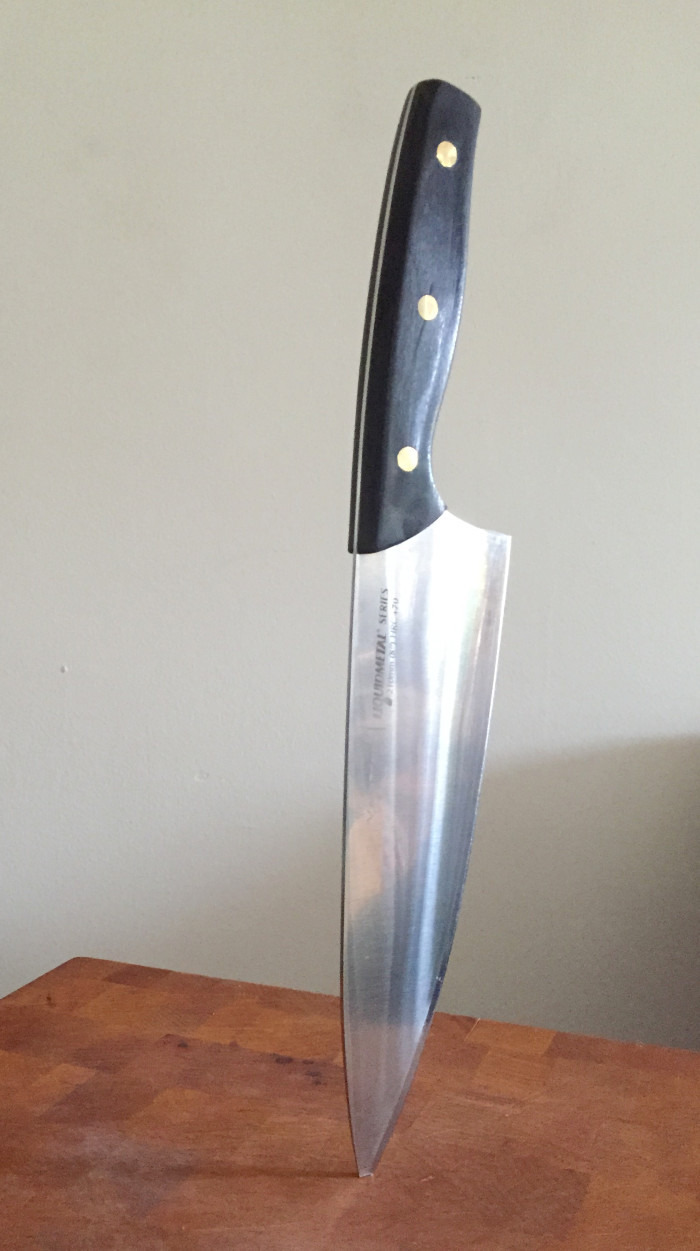Tested: VMatter LiquidMetal Chef's Knife
A proper chef's knife is the single most important tool in any kitchen. I'd be lost without my 8-inch Wusthof, although I've flirted with expensive competitors and seriously considered selling a vital organ for a bespoke walnut and carbon beauty handmade in Brooklyn. Yet despite all these options — and their eye-popping price tags — the steel kitchen knife has remained relatively unchanged for decades. Until now.
First, a little information on ceramic knives: Ceramic knives are relatively new and represent a viable attempt at disrupting a centuries-old history of metalworking. The ceramic won't react with acids (which creates off-flavors in food), and the knives are significantly lighter than their steel predecessors. However, being made of ceramic, the blades are ultimately brittle and inflexible. They won't chop through bones, and using the side of the blade (as you would to make garlic paste) risks damage to the knife and yourself. I need a workhorse in the kitchen, and, simply put, ceramic knives are not that workhorse.
When it comes to buying a knife, there are two basic options: stainless steel and carbon steel. Stainless steel knives are the most common. The blades are strong and easy to maintain, and due to the chromium content, they won't rust or stain. However, the metal is relatively soft, meaning edges wear easily and the knives require frequent sharpening. Carbon steel is significantly harder than stainless and therefore able to maintain its sharper edge longer; however, carbon is extremely high-maintenance and prone to rust and stains. Certain brands even recommend cleaning carbon steel knives while cooking, which, if you're in the midst of prepping a multi-course dinner party, is just unreasonable.

VMatter, a scrappy but serious startup out of Irvine, California, has a solution. They don't have the centuries of expertise and rich legacy of metalworking like their competitors, but they do have something comparable: NASA-tested alloy.
VMatter's LiquidMetal alloy is harder than carbon while remaining ductile, meaning the knife is extremely strong while remaining flexible enough for tasks like filleting. Because of its Hulk-like fortitude, the blade lasts seemingly forever without sharpening and can be finished to a steeper edge: 22 to 24 degrees to be exact. (For comparison, this Shun knife carries a 16-degree edge.) The alloy comprises the lower 3 to 4 millimeters of the blade, where it matters most, while the majority of the knife is stainless steel. Would it be preferable if the entire blade were composed of this Metal of the Future? Probably, but because the LiquidMetal edge is bonded to stainless, VMatter knives avoid all of the risks of unsightly rust and stains.
But technical jargon aside, all I want to know is how it handles a perfectly ripe tomato, so I put my Wusthofs and Shuns to the side. For two weeks, I ran this new-age knife through the wringer, chopping up beef bones and breaking down whole chickens; suprême-ing juicy citrus; pasting unholy amounts of garlic; slicing tomatoes fresh from the farmers' market; prying open weedy lemongrass. I never once reached for the sharpening steel, and after two weeks of heavy abuse, the knife sliced through a ripe summer tomato without a hitch.
The knife is not perfect, however. The handle feels a little flimsy, and the shape of the grip needs more finesse. The stainless steel, which comprises most of the blade, is perfectly serviceable but shows wear faster than I had expected. If you're in the market for a $250-plus piece, there are certainly prettier options out there. But this knife isn't $250. This is a knife for the masses!
Will it eventually need to be sharpened after another two weeks of use? Three months? A year? Only time will tell, but for high-caliber performance at half the price of popular competitors, I'd make this my no-frills kitchen workhorse any day.
VMatter LiquidMetal 8-inch chef's knife, $100 at vmatter.com.

